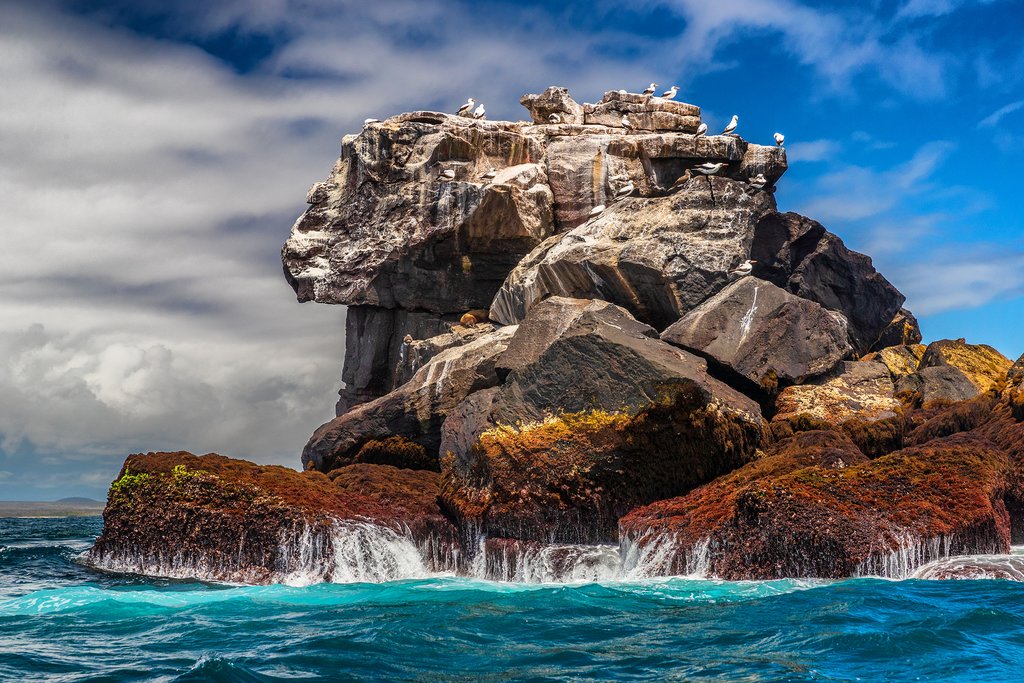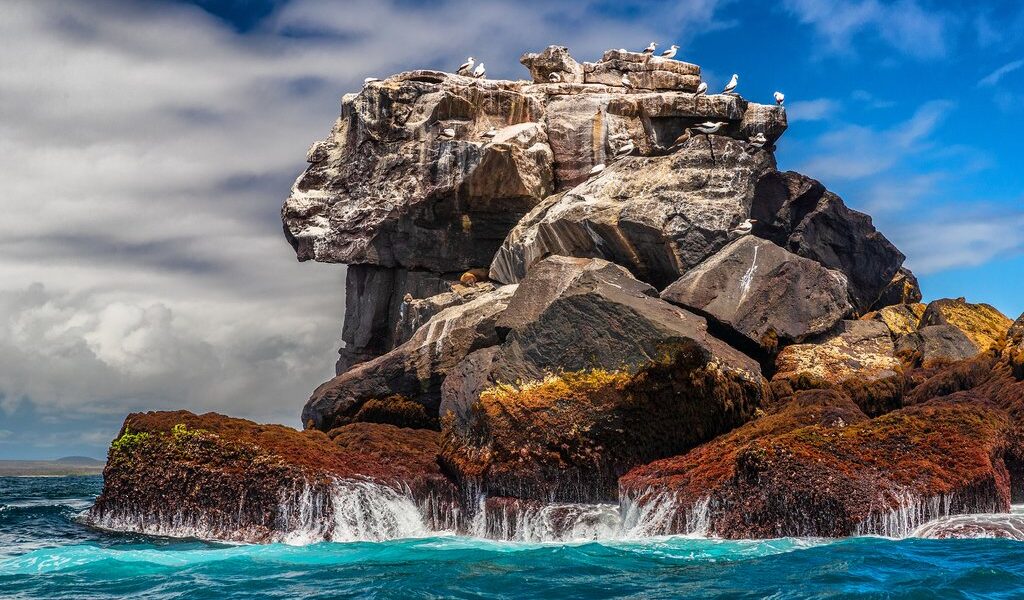
The Galápagos Islands are great to visit at any time of the year, as you will always enjoy warm weather with exciting wildlife and activities. The Galápagos climate is characterized by a rainy season (December-May) and a dry season (June-November), but every season brings something unique, whether you are an adventurous traveler, a birdwatcher, a beach lover, or a nature explorer. Walk in Charles Darwin’s footsteps, observe countless incredible species of reptiles, mammals, and birds, and snorkel or scuba dive among sharks, dolphins, and whales.
## A Comprehensive Guide to Seasonal Travel in the Enchanting Galápagos Islands
The Galápagos Islands, a globally recognized haven for unique biodiversity and breathtaking landscapes, offer a captivating experience throughout the year. Unlike destinations bound by specific seasons for optimal travel, the Galápagos Islands present a compelling case for year-round visitation. The climate remains consistently warm, and the wildlife displays intriguing behaviors regardless of the month. However, each season brings its own distinctive nuances and highlights, shaping the overall experience for travelers. Whether you’re drawn to witnessing the vibrant colors of mating marine iguanas or eager to snorkel alongside playful sea lion pups, the Galápagos Islands promise an unforgettable adventure.
Winter unveils a season of warmth and humidity, ushering in the rainy season. This period offers unique opportunities to witness the captivating display of male marine iguanas showcasing their vibrant hues. Spring continues the reign of the rainy season, maintaining consistently hot weather conditions. This time of year is a period of prolific wildlife activity. Land birds, sea lions, turtles, and tortoises embark on their breeding and nesting cycles, offering captivating insights into their life cycles.
Summer sees the highest influx of visitors, coinciding with the peak of the dry season. The waters grow colder, attracting a surge of extraordinary marine life. This is a great time for underwater activities. As the year progresses into fall, the islands experience a calming trend, with fewer crowds and what many consider to be the most breathtaking sunrises of the year.
## Winter (December through February): Embracing the Rainy Season Amidst Holiday Festivities
Winter on the Galápagos Islands represents one of the two busiest periods for tourism, a time characterized by hot and humid weather, accompanied by the arrival of rain. However, it’s important to note that the rain is not constant, especially early in the season. This leaves plenty of opportunities to revel in the islands’ natural beauty. One can relax on the pristine beaches and partake in a range of water-based activities, including snorkeling, diving, and swimming.
A particularly mesmerizing spectacle occurs in December and January, as male marine iguanas undergo a remarkable transformation, changing their colors to attract the attention of females during their winter mating season. The vibrant displays are a sight to behold and a testament to the islands’ rich biodiversity.
While winter marks a peak season, the crowds are generally smaller than those experienced during the summer months. This allows for a greater chance of finding quiet, peaceful moments to relax and fully appreciate the surroundings. The holiday season, particularly Christmas and New Year’s, tends to be the busiest period. February attracts additional visitors as the vibrant Carnival celebrations take place throughout Ecuador. Temperatures generally range from 75-85 °F (24-29 °C), while water temperatures hover around 80°F (27°C). December typically sees the “lowest” temperatures of the season, with temperatures gradually increasing throughout the winter months.
Boat tours are a popular and highly recommended option for exploring the islands. Spending several days aboard a small cruise ship allows you to immerse yourself in the remarkable wildlife and landscapes. You can snorkel in the turquoise waters, admire the diverse marine life, and explore the unique flora and fauna of each island. Along your journey, you’re likely to encounter marine iguanas, the vibrantly colored greater flamingoes, playful penguins, adorable giant tortoise babies, and unique land iguanas, each adding to the rich tapestry of the Galápagos experience.
In February, the lively Carnival celebrations take place, with the best way to experience the festivities being on Tortuga Bay on Santa Cruz Island. Tortuga Bay is also a renowned sanctuary for the largest and most diverse tortoise communities in the Galápagos. The beach is known for its exceptional beauty. Isla Isabela and Isla Española boast some of the most abundant and captivating animal life during the winter months. They provide excellent opportunities to observe baby tortoises, vividly colored iguanas, and the majestic waved albatross in their natural habitat.
## Spring (March through May): Embracing the Rainy Season and its Abundant Marine Life
Spring in the Galápagos Islands brings with it a blend of heat and humidity, complemented by colder waters. This is perfect for those eager to indulge in snorkeling and diving adventures. The season begins with warm weather and refreshing rainfall, with temperatures averaging around 80-88°F (27-31°C) in March. Towards May, temperatures gently cool to around 72-75 °F (22-24 °C). You can anticipate increased rainfall during the first half of spring, coinciding with the peak of the rainy season. The showers gradually diminish as summer approaches. These rain showers are typically infrequent, followed by bright blue skies. Those wishing to minimize exposure to the rainier part of the season may find it beneficial to plan their trip for the latter part of spring.
During this time of year, the islands are abuzz with activity as various animals and birds begin their nesting cycles. Penguins, greater flamingos, and flightless cormorants all participate in this natural process. There’s also a fascinating event that unfolds between the Galápagos hawks and the giant tortoises. As the tortoise eggs begin to hatch, the hawks attempt to snatch the vulnerable hatchlings. This provides a unique chance for visitors to witness a dramatic natural spectacle.
The waved albatross returns to the islands during this time, with a particular concentration on Isla Española. On Isabela and Fernandina Islands, you will find an abundance of penguin families. Be sure to visit Punta Vicente Roca Isabela, which offers amazing sights during this period. Take advantage of the opportunity to capture stunning photographs as the skies turn bright blue after the rain. Spring also marks the emergence of baby land iguanas and green sea turtles along the shores, making it a particularly enchanting time to visit.
The superb underwater visibility during the spring months enhances the experience of observing the marine life below the surface. Numerous island cruises are available, often including snorkeling opportunities. Scuba diving excursions are also available for experienced divers. Spring is also an ideal time to relax and soak up the sun on the beautiful beaches of the Galápagos. On North Seymour Island, visitors can witness the unique courtship dance of the rare blue-footed boobies, a truly unforgettable sight.
During this time you’ll likely encounter mating sea lions and witness the birth of new pups. In the port of Puerto Ayora, Galápagos sea lions have become accustomed to taking their afternoon siestas on park benches rather than on the beach. As summer approaches, the rains subside and temperatures drop slightly, creating ideal conditions for full-day land-based activities and adventures. It is an excellent opportunity to enjoy hiking, mountain biking, and tracing the footsteps of Charles Darwin on a guided tour.
## Summer (June through August): Peak Travel Season and Marine Abundance
As the waters around the Galápagos Islands turn colder during the summer months, nutrient-rich currents attract a plethora of marine life. This season is arguably the best time to indulge in the wonders of snorkeling, as you will encounter an abundance of dolphins and whales. Fernandina Island is particularly renowned as one of the prime locations for spotting incredible marine life, including the elusive whale sharks. A visit to Seymour Island offers the chance to witness the striking red throat pouches of male frigatebirds, a captivating display of courtship.
Other exciting activities to enjoy during the summer include paddleboarding, mountain biking, hiking, and kayaking. These adventures provide opportunities to explore the diverse coastline and inland landscapes. Temperatures generally range from 70-76°F (21-24°C), while water temperatures average around 76°F (24°C), creating pleasant conditions for swimming and enjoying the marine environment. The dry season on the Galápagos Islands commences in June. The dry season is also the beginning of the Garúa season, characterized by reduced water clarity, cloudier skies, and occasional mist.
Summer represents the busiest period for tourism across the islands. Therefore, it is highly recommended to book your trip well in advance to secure accommodations and tours. There is a particularly high demand for boat tours during this time.
Bird-watching is one of the summer’s most captivating highlights. You can witness the enchanting rituals of the friendly blue-footed boobies.
The lava lizards commence their courtship rituals in July, and they can be observed in abundance on all islands. They can’t be seen on Genovesa, Darwin, and Wolf Island. Isla Santa Cruz provides opportunities to observe a large number of giant tortoises, while Isla San Cristobal offers encounters with charming baby sea lions.
## Fall (September through November): Fur Seal and Sea Lion Season
In the fall, the Galápagos Islands experience a transitional period in weather patterns, as temperatures begin to gradually rise and the approach of the rainy season becomes noticeable. This season offers an ideal opportunity to enjoy moments of tranquility on the Galápagos Islands and indulge in snorkeling alongside penguins along Bartolomé Island. The Galápagos fur seals also make their grand arrival to the islands during this time. You’re sure to encounter them on Isabela Island, where they can be found occupying space on the beaches and even venturing into the city, taking up residence on pavements and benches.
Each month during the fall brings something unique and exciting to the Galápagos. In September, the Galápagos penguin exhibits heightened activity levels. October offers a prime opportunity to witness breathtaking sunrises and dramatic sunsets, painting the sky with vibrant colors. November marks the beginning of a new chapter for the fur seal and sea lion pups, as they bravely enter the waters for the first time. You’re likely to encounter them as you swim and snorkel in the seas surrounding the Galápagos Islands. These playful and curious creatures often display a fascination with humans, enriching the overall experience.
The fall season also presents an advantageous time to find attractive deals on hotels, flights, and tours. With the exception of the North American Thanksgiving season and All Soul’s Day, the islands tend to be quieter during this period, resulting in more affordable travel options. Temperatures typically hover around 70 °F (21 °C) at the beginning of fall, with water temperatures approximately the same. Both gradually become warmer as winter approaches.
Fall is an ideal time to indulge in bird-watching, as seabirds are particularly active in October. Commonly sighted species include blue-and red-footed boobies, penguins, greater flamingoes, frigate birds, and flightless cormorants. A hike to Pinnacle Rock on Bartolomé Island offers a chance to enjoy panoramic sea views. Galápagos green sea turtles are particularly active during this time, and they can often be observed while snorkeling offshore or even spotted resting on the beaches.
Snorkeling and swimming are particularly enjoyable in the fall. This is due to the pleasant weather conditions, the vibrant marine life, and the retreat of the cold Humboldt Current away from the islands. Head to Isla Fernandina to swim among penguins, marine iguanas, and potentially spot some playful dolphins. A visit to the Devil’s Crown—a volcanic crater almost completely submerged in the ocean—promises an unforgettable snorkeling experience. You could also head to Sullivan Bay on the coast of Isla Santiago.
B-883

